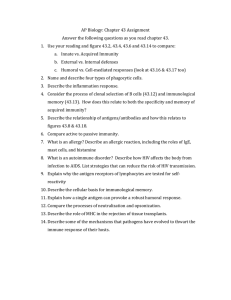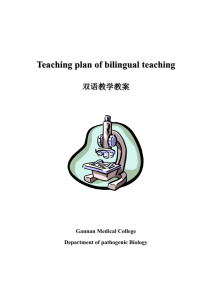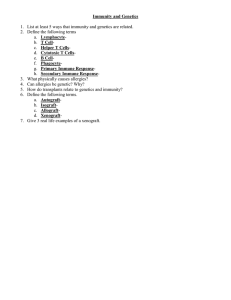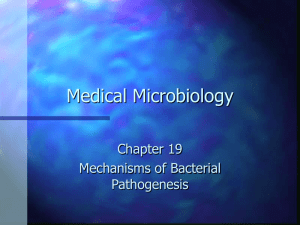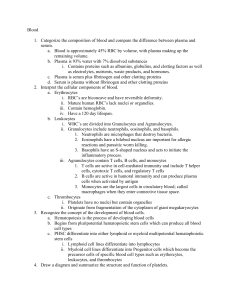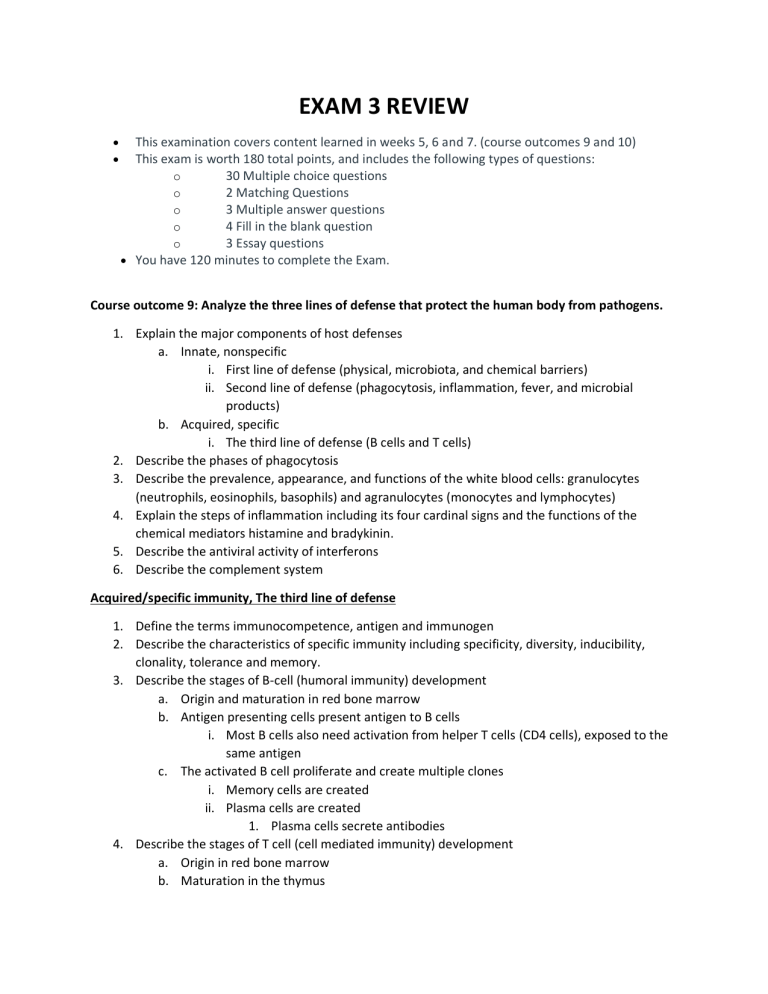
EXAM 3 REVIEW • • This examination covers content learned in weeks 5, 6 and 7. (course outcomes 9 and 10) This exam is worth 180 total points, and includes the following types of questions: o 30 Multiple choice questions o 2 Matching Questions o 3 Multiple answer questions o 4 Fill in the blank question o 3 Essay questions • You have 120 minutes to complete the Exam. Course outcome 9: Analyze the three lines of defense that protect the human body from pathogens. 1. Explain the major components of host defenses a. Innate, nonspecific i. First line of defense (physical, microbiota, and chemical barriers) ii. Second line of defense (phagocytosis, inflammation, fever, and microbial products) b. Acquired, specific i. The third line of defense (B cells and T cells) 2. Describe the phases of phagocytosis 3. Describe the prevalence, appearance, and functions of the white blood cells: granulocytes (neutrophils, eosinophils, basophils) and agranulocytes (monocytes and lymphocytes) 4. Explain the steps of inflammation including its four cardinal signs and the functions of the chemical mediators histamine and bradykinin. 5. Describe the antiviral activity of interferons 6. Describe the complement system Acquired/specific immunity, The third line of defense 1. Define the terms immunocompetence, antigen and immunogen 2. Describe the characteristics of specific immunity including specificity, diversity, inducibility, clonality, tolerance and memory. 3. Describe the stages of B-cell (humoral immunity) development a. Origin and maturation in red bone marrow b. Antigen presenting cells present antigen to B cells i. Most B cells also need activation from helper T cells (CD4 cells), exposed to the same antigen c. The activated B cell proliferate and create multiple clones i. Memory cells are created ii. Plasma cells are created 1. Plasma cells secrete antibodies 4. Describe the stages of T cell (cell mediated immunity) development a. Origin in red bone marrow b. Maturation in the thymus c. Antigen presenting cells present antigen to helper T cells (CD4 cells) d. The activated helper T cell i. Activates cytotoxic T cells (CD8 cells) ii. Create memory helper T cells iii. Differentiate into regulatory T cells e. Activated cytotoxic T cells i. Create memory cytotoxic T cells ii. Destroy infected host cells 5. Describe the structures, functions, and characteristics of the five classes of immunoglobulins 6. Explain and provide examples of the four types of acquired immunity Course Outcome 10: Analyze the microbial diseases of different body systems-integumentary, nervous, circulatory, respiratory, digestive, and urogenital. SKIN & EYES 1. Staphylococcus aureus (morphology and Gram stain) 2. Discuss the signs and symptoms, pathogenesis, virulence factors and transmission of the following diseases caused by Staphylococcus aureus a. MRSA b. Impetigo c. SSSS d. Necrotizing fasciitis 3. Discuss the causative agents, signs and symptoms, pathogenesis, virulence factors and transmission for the following diseases a. Gas gangrene b. Chicken pox c. Shingles d. Measles e. Cutaneous anthrax NERVOUS SYSTEM 1. Discuss the causative agents, signs and symptoms, pathogenesis, virulence factors and transmission for the following diseases a. Polio b. Variant Creutzfeldt-Jakob disease c. Mad cow disease CARDIOVASCULAR AND LYMPHATIC SYSTEMS 1. Differentiate the terms sepsis, bacteremia, viremia, and fungemia 2. Discuss the causative agents, signs and symptoms, pathogenesis, virulence factors, and transmission for the following diseases a. Mononucleosis b. Lyme disease c. Plague 3. Human Immunodeficiency Virus and AIDS a. Differentiate HIV from AIDS b. Explain the relationship between HIV pathogenesis and acquired/specific immunity i. Helper T cells (CD4 cells) ii. Cytotoxic T cells (CD8 cells) c. Signs and symptoms of HIV infection and AIDS d. Explain the changes in the levels of viral antigen, CD4 helper T cells and antibodies to HIV in the blood during the progression of untreated HIV infection. RESPIRATORY 1. Differentiate antigenic shift and antigenic drift for the influenza virus. 2. Discuss the diagnosis, treatment, causative agents (Gram staining and morphology), virulence factors, signs and symptoms, and pathogenesis for the following diseases a. Streptococcal pharyngitis b. Diptheria c. Tuberculosis GASTROINTESTINAL 1. Discuss the causative agent, signs and symptoms, virulence factors, transmission, and treatment of gastric ulcers. 2. Shiga-toxin producing Escherichia coli (STEC) a. Gram stain and morphology b. Signs and symptoms c. Virulence factors d. Transmission 3. Briefly describe the following categories of Escherichia coli a. ETEC b. EIEC c. EPEC d. EAEC e. DAEI 4. Clostridium difficile a. Signs and symptoms b. Antibiotics as precipitating factors c. Morphology and Gram staining 5. Food poisoning (Staphylococcus aureus exotoxin) a. Types of foods associated with illness b. Prevention c. Inactivation of toxin Genitourinary 1. Describe the pathogenesis, virulence factors, and transmission of vaginitis due to Candida albicans. 2. Describe the causative agent, signs and symptoms, pathogenesis, virulence factors and transmission of gonorrhea. 3. Describe the Tuskegee Study of Untreated Syphilis in the Negro male 4. Describe the causative agent (Gram stain and morphology), clinical stages, and treatment of syphilis. 5. Explain the signs and symptoms and transmission of congenital syphilis.
